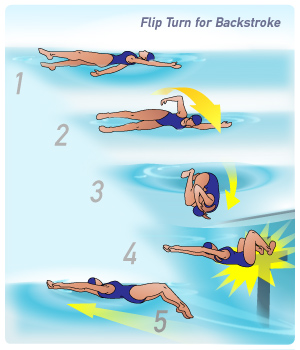How to Do a Backstroke Flip Turn
September 11, 2014

A flip turn in freestyle can seem confusing enough. Trying to flip over while swimming backstroke can seem impossible! Although a backstroke flip turn requires a little added finesse, in reality it’s nearly identical to the freestyle flip turn. With tips from this guide — and a little practice — you should have no trouble flipping yourself over.
Oftentimes, approaching the wall is the most nerve-racking part of the turn. Let’s start off by flipping away from the wall.
Flip in the Middle of the Pool
Push off the wall on your back. Then perform six strokes of backstroke and take one freestyle stroke to roll you over onto your stomach. Next, do a somersault right there in the middle of the lane. Your backstroke flip turn should feel identical to your freestyle flip turn.
Swim Straight
When you first do this, you might go a little crooked. As you turn onto your stomach, keep your body as straight as possible. Make sure your shoulders are flat on top of the water as you roll into your turn. If your shoulders are tilted as you go into your turn, chances are you’ll flip crooked.
Repeat, Repeat, Repeat
After you’ve completed your flip, get your bearings and repeat the same steps. Perform six more strokes, a freestyle stroke, and a somersault. Keep repeating this drill until you feel comfortable with your flip turn.
Exhale
The burning feeling of getting water up your nose is the worst! If you’re experiencing this awful sensation, try exhaling as you do your flip. If air is leaving your nose, water can’t get in.
Before you can perform a flip at the wall, you need to get your stroke count down. For many swimmers, approaching the wall on your back can be the most intimidating part of backstroke turns. If you get your stroke count down, you’ll feel much more comfortable approaching the wall for your turn.
Count from the Backstroke Flags
Start in the middle of the pool. Push off the pool floor and swim backstroke towards the wall. As you pass the backstroke flags, start counting your arm strokes. Approach the wall and finish on your back.
 When you’re comfortable with your stroke count, you’re ready to practice a flip at the wall. Take your stroke count and subtract one — for the freestyle stroke. For example: If your stroke count was six, you will perform five backstroke strokes and one freestyle stroke.
When you’re comfortable with your stroke count, you’re ready to practice a flip at the wall. Take your stroke count and subtract one — for the freestyle stroke. For example: If your stroke count was six, you will perform five backstroke strokes and one freestyle stroke.
As you approach the wall, perform the strokes in your stroke count and flip at the wall. At this point, do not push off. Place your feet on the wall and take note of where they land.
Too Near
It makes a huge difference where your feet land on the wall. If you’re too near, your buttocks will be near to your heels. You will have to exert a ton of energy to get off the wall, while wasting time on the wall. No one wants to hold their breath longer than they have to! Also, if you’re too near, then your feet might hit the wall high. This can push you down deep in the water as you leave the wall.
To adjust your distance from the wall, play around with your stroke count. Try taking a stroke away from your count, and see if you’re too far away from the wall.
Too Far
If you’re too far, you’ll feel like you can hardly push off the wall. This will cause you to have little or no power as you leave the wall, leaving you underneath the water for a long time. Once again, you’ll have to hold your breath longer than you’ll want to. There’s also a good chance that your feet might hit low, which will push you towards the surface too quickly.
To adjust your distance if you’re too far from the wall, try kicking a little harder. Adding a stroke might work if you’re really far, but it also might get you too close to the wall. Kicking harder will get you closer to the wall if you just need a little extra boost.
Just Right
Your feet will hit the center of the cross if you are the right distance from the wall. This will create a roughly 90 degree angle between your calf and your thigh. Think about it like this: If your feet hit the wall at about an ideal 90 degree angle, it will feel like you’re sitting in a chair. From this distance, you’ll bounce off the wall quickly and with little effort.
Now that you’re the correct distance from the wall and you feel comfortable flipping over, you’re ready to practice a full flip turn. Follow the same steps as you did in Step 3. This time, flip at the wall before pushing off on your back in a streamline. As you push off, make sure your back is parallel to the bottom of the pool. Think about where your feet are hitting to help you push off straight.
Build Confidence
Becoming proficient at your backstroke flip turn depends a lot on how comfortable you feel. The more you practice, the more confident you’ll be. Even if the turn seems nearly impossible at first, keep at it. You’ll get the hang of it as you go!



